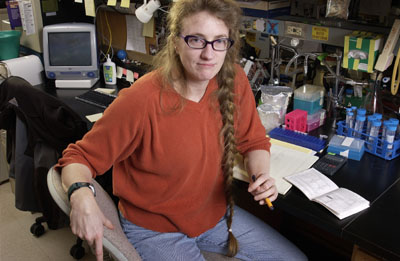January 30, 2003
Microtubules and chromosomes: The Science in Medicine Lecture
For many years molecular biologists have watched the process of cell division under the microscope.
“If a chromosome is gained or lost it’s often ‘curtains’ for the cell,” explains Dr. Linda Wordeman, associate professor of physiology and biophysics. “In a cancerous tumor, most of the cells appear to have the wrong number of chromosomes. Sometimes cells have mutations that allow them to escape a variety of checkpoints that the cell has in place to sense when a mistake in chromosome segregation has been made. And when this happens it is usually bad news for the organism.”
Wordeman will be talking about her research in the Science in Medicine lecture, Order from Chaos: Microtubule Dynamics and Chromosome Segregation, at noon Thursday, Feb. 6 in A-420 Hogness Auditorium, Health Sciences Center. The lecture is free and open to the public.
During cell division the individual chromosomes go through a random process of capture, movement and alignment on the mitotic spindle that, amazingly, ensures that the two daughter cells receive the exact same genes. Wordeman and her colleagues are studying microtubules, strands of protein inside the cell that help regulate which chromosomes go where during cell division.
“Microtubules serve as rails on which protein complexes and organelles are transported inside the cell and they also correspond to the skeleton of the cell — the cytoskeleton,” says Wordeman. “The weird thing about microtubules is that despite the fact that they contribute to the overall cell structure and shape, microtubules are actually very dynamic. It’s really amazing, if one looks at this in a time lapse film, the microtubules look like laser beams probing the cytoplasm.”
During cell division, the nuclear envelope breaks down. The microtubules attach to a specialized region on the surface of the chromosome: the centromere or kinetochore. The microtubules are actually polymerizing and depolymerizing all the time, allowing chromosomes to be “caught” on the microtubule. Once caught the chromosome begins to oscillate back and forth on the ends of the microtubule. This explains the root of the word kinetochore, which is Greek for “moving place.”
“When cells divide, the microtubules reorganize into this beautiful
spindle,” says Wordeman. “The spindle is composed of two poles that will eventually give rise to two daughter cells. The capture of chromosomes by the microtubule is a random process. And yet, once captured by the spindle the chromosomes all manage to make their way to the center and segregate to the poles — they have to do this with perfect fidelity.”
Wordeman and her lab group are also studying a protein that modulates microtubule polymerization and depolymerization. Mitotic centromere-associated kinesin (MCAK) helps ensure that the correct number and complement of chromosomes get to each daughter cell during cell division.
“You can have a serious mutation in a gene that is involved in cell
division, and as long as the chromosomes get properly segregated, you may not ever have cancer show up,” says Wordeman. “If, during the course of cell division, one cell drops or gains a chromosome by accident, then you are really on the way to tumor progression. So cell division has to be accomplished with perfect fidelity — we’re finding out that MCAK is one protein that regulates this process in conjunction with microtubules.”
Wordeman received a Ph.D. in zoology from the University of California, Berkeley. She came to the UW in 1994 as an assistant professor of physiology and biophysics. Previously she was a postdoctoral fellow at the University of California San Francisco Department of Pharmacology and a visiting scientist at the University of Hawaii. Among her numerous awards are the National Science Foundation Predoctoral Fellowship, the Helen Hay Whitney Postdoctoral Fellowship and the Bank of America Giannini Postdoctoral Fellowship. Wordeman is currently on the editorial advisory board for Cell Biology International.



